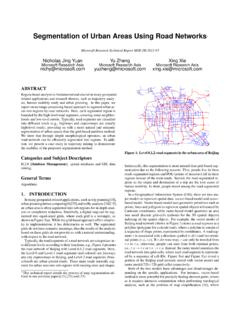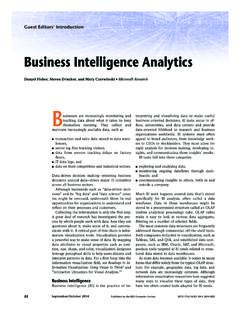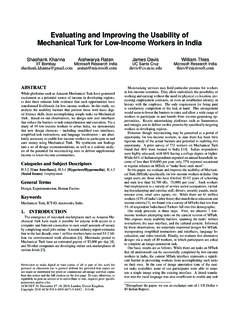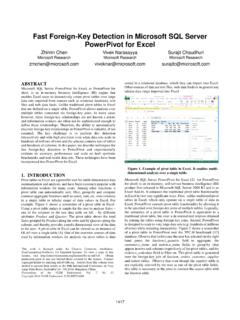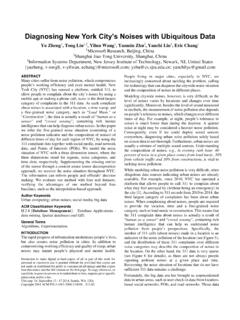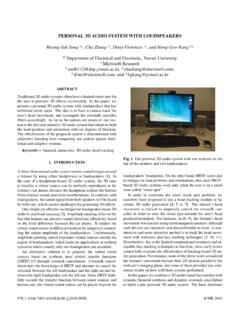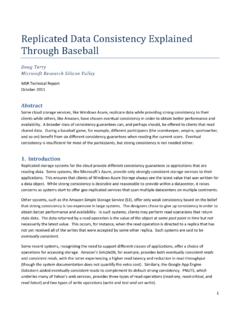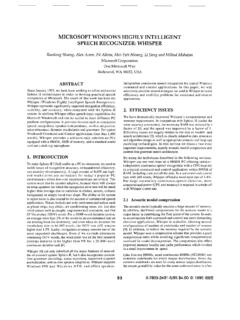Transcription of Seven Properties of Highly Secure Devices - microsoft.com
1 The Seven Properties of Highly Secure Devices Galen Hunt, George Letey, and Edmund B. Nightingale microsoft Research NExT Operating Systems Technologies Group ABSTRACT. Industry largely underestimates the critical societal need to embody the highest levels of security in every network-connected device every child's toy, every household's appliances, and every industry's equipment. High development and maintenance costs have limited strong security to high-cost or high- margin Devices . Our group has begun a research agenda to bring high-value security to low-cost Devices . We are especially concerned with the tens of billions of Devices powered by microcontrollers. This class of Devices is particularly ill-prepared for the security challenges of internet connectivity. Insufficient investments in the security needs of these and other price-sensitive Devices have left consumers and society critically exposed to device security and privacy failures.
2 This paper makes two contributions to the field of device security. First, we identify Seven Properties we assert are required in all Highly Secure Devices . Second, we describe our experiment working with a silicon partner to revise one of their microcontrollers to create a prototype, Highly Secure microcontroller. Our experimental results suggest that in the near future even the most price-sensitive Devices should be redesigned to achieve the high levels of device security critical to society's safety. While our first experimental results are promising, more ongoing research remains and we seek to enlist the broader security community in a dialog on device security. 1. INTRODUCTION. The next decade promises the universal democratization of connectivity to every device. Significant drops in the cost of connectivity mean that every form of electrical device every child's toy, every household's appliances, and every industry's equipment will connect to the Internet.
3 This Internet of Things (IoT) will drive huge economic efficiencies; it will enable countless innovations as digital transformation reaches across fields from childcare to eldercare, from hospitality to mining, from education to transportation. Although no person can foresee the full impact of universal device connectivity, anticipation of this new frontier is widespread [1] [2]. Industry largely underestimates the critical need for the highest levels of security in every network- connected device. Even the most mundane device can become dangerous when compromised over the Internet: a toy can spy or deceive [3], an appliance can launch a denial of service [4] or self-destruct, a piece of equipment can maim or destroy [5]. With risks to life, limb, brand, and property so high, single- line-of-defense and second-best solutions are not enough. We don't want to be alarmists.
4 Although the state-of-the-art of security of internet-connected Devices leaves much to be desired, we are quite optimistic for the future of device security. We believe it is within the realm of achievability for all Devices , even the most price sensitive, to be engineered with 1. sufficient security to be trustworthy even in the face of aggressive assault from determined network attackers. Our fears and our hopes for connected device security are grounded in decades of microsoft experience as an active defender in the Internet security battle. Early attacks against network Devices motivated microsoft to pioneer automated remote update of Devices in the field in Windows 95 [6]. Ongoing, evolving attacks motivated microsoft to pioneer automated reporting and analysis of security attacks against Windows Devices starting with Windows XP [7]. The desire to avoid in-field vulnerabilities continues to motivate microsoft to create technologies and automated tools to detect and address vulnerabilities at design time [8] [9].
5 The goal of our research is to enable manufacturers, regardless of industry, to incorporate the highest levels of security in every network-connected device. We have identified Seven necessary Properties of Highly Secure , network-connected Devices : a hardware-based root of trust, a small trusted computing base, defense in depth, compartmentalization, certificate-based authentication, security renewal, and failure reporting (in Section 2). For any network-connected device to be Secure , we assert it must possess all Seven of these Properties . To implement these Seven Properties , the hardware and software (firmware) of the device must work together, with device security rooted in hardware, but guarded with Secure , evolving software. We find these security Properties especially lacking in microcontroller-based Devices . Some microcontroller families are beginning to evolve security features in hardware, such as cryptographic engines.
6 However, just providing cryptographic acceleration or private key storage isn't enough to create a Highly Secure device if the microcontroller doesn't also provide defense in depth or compartmentalization. Overall, traditional microcontrollers lack sufficient security features to support implementation of Devices with all Seven Properties of Highly Secure Devices . To address the security challenges facing network-connected Devices that are powered by microcontrollers, we enlisted the help of MediaTek to revise one of their existing microcontrollers to create a Sopris, a proof-of-concept Highly Secure microcontroller (described in Section 4). Sopris is an experimental chip that allows us to explore the ability to create experimental microcontroller-powered systems that embody the Seven Properties of Highly Secure Devices . The key hardware innovations in Sopris1 are the addition of a security subsystem and the inclusion of a memory management unit (MMU).
7 In the primary processor of the microcontroller. These innovations create a microcontroller architecture that we believe if combined with appropriate software would allow the creation of Highly Secure Devices . 2. Properties OF Highly Secure Devices . Building Secure Devices is challenging. From observation of existing best-in-class Devices , we argue it is more of a science than an art. If one adheres rigorously to well-understood principles and practices, building Secure Devices is repeatable. We have identified Seven Properties we assert must be shared by all Highly Secure , network-connected Devices : a hardware-based root of trust, a small trusted computing 1. The name comes from the twin-summit Mount Sopris in the Elk Mountains of western Colorado. 2. base, defense in depth, compartmentalization, certificate-based authentication, security renewal, and failure reporting (summarized in Table 1).
8 Property Examples and Questions to Prove the Property Unforgeable cryptographic keys generated and protected by Hardware-based hardware. Physical countermeasures resist side-channel attacks. Root of Trust Does the device have a unique, unforgeable identity that is inseparable from the hardware? Private keys stored in a hardware-protected vault, inaccessible to Small Trusted software. Division of software into self-protecting layers. Computing Base Is most of the device's software outside the device's trusted computing base? Multiple mitigations applied against each threat. Countermeasures mitigate the consequences of a successful attack on any one vector. Defense in Depth Is the device still protected if the security of one layer of device software is breached? Hardware-enforced barriers between software components prevent a breach in one from propagating to others. Compartmentalization Does a failure in one component of the device require a reboot of the entire device to return to operation?
9 Signed certificate, proven by unforgeable cryptographic key, proves Certificate-based the device identity and authenticity. Authentication Does the device use certificates instead of passwords for authentication? Renewal brings the device forward to a Secure state and revokes Renewable Security compromised assets for known vulnerabilities or security breaches. Is the device's software updated automatically? A software failure, such as a buffer overrun induced by an attacker Failure Reporting probing security, is reported to cloud-based failure analysis system. Does the device report failures to its manufacturer? Table 1. Required Properties of Highly Secure Devices with Examples. Highly Secure Devices have a hardware-based root of trust. Device secrets are protected by hardware and the hardware contains physical countermeasures against side-channel attacks. Unlike software, hardware has two important Properties that may be used to establish device security.
10 First, single- purpose hardware is immune to reuse by an attacker for unintended actions. Second, hardware can detect and mitigate against physical attacks; for example, pulse testing the reset pin to prevent glitching attacks is easily implemented in hardware. When used to protect secrets and device correctness, hardware provides a solid root of trust upon which rich software functionality can be implemented securely and safely. 3. Highly Secure Devices have a small trusted computing base. The trusted computing base (TCB) consists of all the software and hardware that are used to create a Secure environment for an operation. The TCB should be kept as small as possible to minimize the surface that is exposed to attackers and to reduce the probability that a bug or feature can be used to circumvent security protections. On the contrary, in less Secure systems, all security enforcement is implemented in a software stack that contains no protection boundaries.
